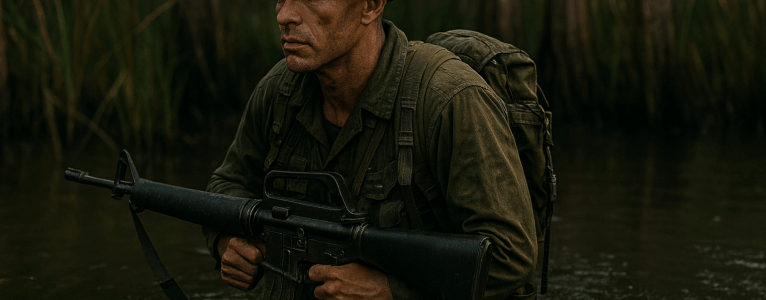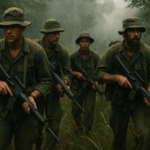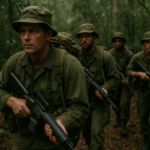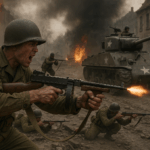
In the jungles of Vietnam, there were missions so absurdly lopsided, so suicidal on paper, they sound like war movie scripts. But for Long Range Reconnaissance Patrol (LRRP) teams, small units of 4 to 6 men dropped deep into enemy territory, this was just Tuesday.
These were the men who slipped past NVA regiments, gathered intelligence within spitting distance of enemy camps, and occasionally found themselves toe-to-toe with entire battalions. When contact happened, it wasn’t about fighting toe-to-toe, it was about surviving, evading, and if necessary, unleashing hell just long enough to get out.
Here are three real missions where fewer than half a dozen LRRPs went up against enemy forces that outnumbered them 100 to 1, and lived to tell the tale.
1. Team Wildcat, 101st Airborne, A Shau Valley (1968)

In May 1968, Team Wildcat, part of Company L, 75th Infantry (Ranger), was inserted into the infamous A Shau Valley, a hotspot crawling with North Vietnamese regulars and Viet Cong. Their mission: locate enemy troop movements near a suspected supply trail.
What they found was worse.
After tracking multiple fresh trails and overhearing Vietnamese radio chatter, the five-man team realized they were in the middle of a major NVA staging area, likely a regimental base camp. As they called in coordinates, their radio operator whispered, “They’re all around us.”
They attempted to exfiltrate under cover of darkness, but were spotted crossing a creek bed. A firefight erupted. Despite being surrounded and outgunned, the LRRPs used claymore mines, suppressed M16s, and grenades to break contact. The team leader coordinated an emergency extraction while calling in artillery danger-close to mask their escape.
Three team members were wounded, but all five made it out alive by hugging the jungle floor until a slick (Huey) found a hole big enough to drop a ladder.
“It was like we kicked over a damn ant hill,” one team member recalled years later. “But those ants had AKs and mortars.”
2. MACV-SOG Recon Team Idaho, Laos Border (1970)
While technically not LRRPs in name, MACV-SOG recon teams shared the same DNA: tiny teams, deep ops, no backup. In March 1970, RT Idaho, six men strong, inserted by helicopter just west of the Vietnamese border to monitor enemy logistics.
Within 24 hours, they’d stumbled onto what appeared to be a truck convoy unloading supplies near a major junction of the Ho Chi Minh Trail.
Then came the dogs. Literal dogs, NVA tracker teams.
RT Idaho’s point man spotted them first. Within minutes, the team was flanked and under fire from at least a company-sized element, later estimated to be the advance scouts of a full battalion. Their only choice was to move fast and make noise—setting off claymores, tossing CS gas, and calling in airstrikes nearly on top of their own position.
The kicker? The team’s Montagnard interpreter was hit and nearly unconscious. The team leader refused to leave him. Instead, they hunkered under a fallen tree, repelled multiple assaults, and finally got pulled out after five hours of gunfire, evasion, and fast-movers (A-1 Skyraiders) bombing a hilltop into dust.
3. LRRP Team 2-6, Americal Division, Quang Ngai Province (1969)

April 1969. A six-man team from the Americal Division’s LRRP detachment inserted near a suspected NVA bivouac. After two days of low-crawling and observation, they spotted something no one expected: an entire battalion-sized formation moving through the valley, complete with pack animals, heavy weapons, and artillery support.
The team relayed coordinates, then tried to exfil. But the jungle was too thick, and the NVA were alerted.
What followed was a textbook breakout: the team laid overlapping ambushes, used baiting techniques (leaving behind gear to fake their position), and circled back over their own trail to confuse trackers. Twice, they engaged in short, violent bursts to break contact before disappearing again.
They evaded for 48 hours straight, barely sleeping, until a fast rope extraction pulled them out during a monsoon squall. The intel they gathered was later used to redirect artillery and B-52 strikes, halting an NVA offensive aimed at Quang Ngai city.
Small Teams. Big Impact.
The power of LRRP teams wasn’t in numbers, it was in force multiplication. Each team operated like the eyes of the division, capable of calling in precise strikes, creating confusion, and delivering chaos with minimal footprint. They avoided open battle, but when contact was forced, they fought like ghosts with teeth.
And when five guys went up against five hundred? The goal wasn’t glory. It was survival.
But damn if it didn’t leave a mark.
If you’re hungry for more stories like this, told from the mud-soaked boots of the men who lived them, check out my new historical fiction novel Rangers: Recon Patrol. It follows an elite LRRP team deep behind enemy lines during the Vietnam War, blending real-world tactics, heart-pounding missions, and the raw brotherhood that kept these men alive. Based on true operations and firsthand accounts, this story doesn’t just salute the legend of the LRRPs, it walks right beside them.





